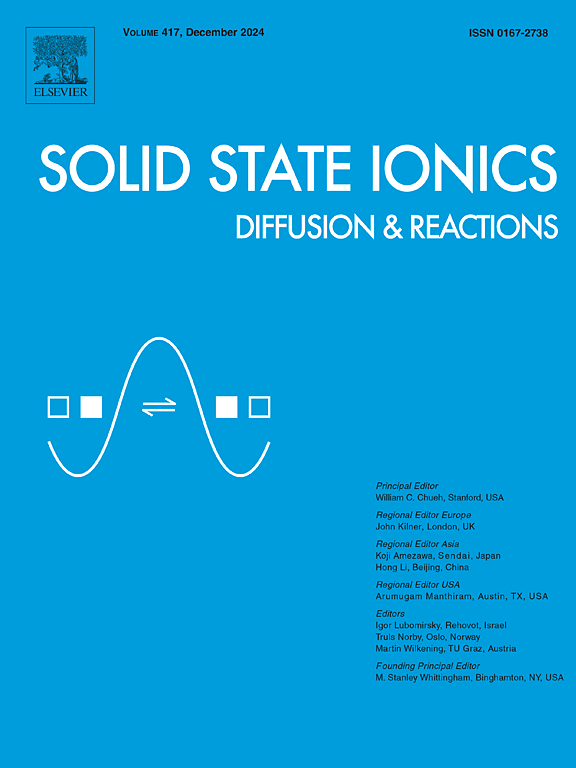Mechanical-electrochemical coupling patterns in all-solid-state lithium batteries employing sulfide- and halide-based solid electrolytes
IF 3.3
4区 材料科学
Q3 CHEMISTRY, PHYSICAL
引用次数: 0
Abstract
The mechanical properties of inorganic solid electrolytes are strongly coupled with their electrochemical performance in all-solid-state lithium batteries (ASSLBs). Herein, we report distinct mechanical-electrochemical coupling patterns between sulfide- and halide-based solid electrolytes through dynamic pressure modulation. We designed a multi-channel pressure-electrochemistry coupling platform (pressure range: 0–380 MPa, resolution: ± 0.01 MPa) to elucidate how pressure conditions govern interfacial contact stability and cycling performance. For sulfide-based systems (e.g., Li6PS5Cl, LPSC), a dynamic pressure controlling protocol allows the regulation of electrolyte creep behavior, enabling sustained interfacial contact for electrochemical reactions. This approach achieves an specific capacity of 227.3 mAh g−1 and capacity retention of 89.1 % after 300 cycles for a typical Li-In||LiNi0.93Co0.02Mn0.05O2 cell. In contrast, halide-based systems employing Li3InCl6 (LIC) require a constant and high external pressure to maintain electrochemical stability. Mechanistic studies attribute the enhanced performance of LPSC to its stress-adaptive creep behavior, which dynamically stabilizes interfaces during cycling. Conversely, the lower resilience and toughness of LIC necessitate sustained external pressure to preserve solid-solid contacts in both bulk electrolyte and composite cathodes. These findings establish tailored pressure management protocol for sulfide- and halide-based electrolytes, providing guidelines for further optimization of the electrochemical performance of ASSLBs via mechanical-electrochemical coupling strategies.
采用硫化物和卤化物固体电解质的全固态锂电池的机械-电化学耦合模式
在全固态锂电池(ASSLBs)中,无机固体电解质的力学性能与其电化学性能密切相关。在此,我们报告了通过动态压力调制硫化物和卤化物基固体电解质之间不同的机械-电化学耦合模式。我们设计了一个多通道压力-电化学耦合平台(压力范围:0-380 MPa,分辨率:±0.01 MPa),以阐明压力条件如何影响界面接触稳定性和循环性能。对于基于硫化物的体系(如Li6PS5Cl, LPSC),动态压力控制协议允许调节电解质蠕变行为,从而实现电化学反应的持续界面接触。对于典型的Li-In b| LiNi0.93Co0.02Mn0.05O2电池,该方法在300次循环后获得了227.3 mAh g−1的比容量和89.1%的容量保持率。相比之下,采用Li3InCl6 (LIC)的卤化物基系统需要恒定的高外部压力来保持电化学稳定性。力学研究将LPSC性能的增强归因于其应力自适应蠕变行为,该行为在循环过程中动态稳定界面。相反,低弹性和韧性的LIC需要持续的外部压力来保持体电解质和复合阴极中的固体-固体接触。这些发现为硫化物和卤化物电解质建立了量身定制的压力管理方案,为通过机械-电化学耦合策略进一步优化ASSLBs的电化学性能提供了指导。
本文章由计算机程序翻译,如有差异,请以英文原文为准。
求助全文
约1分钟内获得全文
求助全文
来源期刊

Solid State Ionics
物理-物理:凝聚态物理
CiteScore
6.10
自引率
3.10%
发文量
152
审稿时长
58 days
期刊介绍:
This interdisciplinary journal is devoted to the physics, chemistry and materials science of diffusion, mass transport, and reactivity of solids. The major part of each issue is devoted to articles on:
(i) physics and chemistry of defects in solids;
(ii) reactions in and on solids, e.g. intercalation, corrosion, oxidation, sintering;
(iii) ion transport measurements, mechanisms and theory;
(iv) solid state electrochemistry;
(v) ionically-electronically mixed conducting solids.
Related technological applications are also included, provided their characteristics are interpreted in terms of the basic solid state properties.
Review papers and relevant symposium proceedings are welcome.
 求助内容:
求助内容: 应助结果提醒方式:
应助结果提醒方式:


